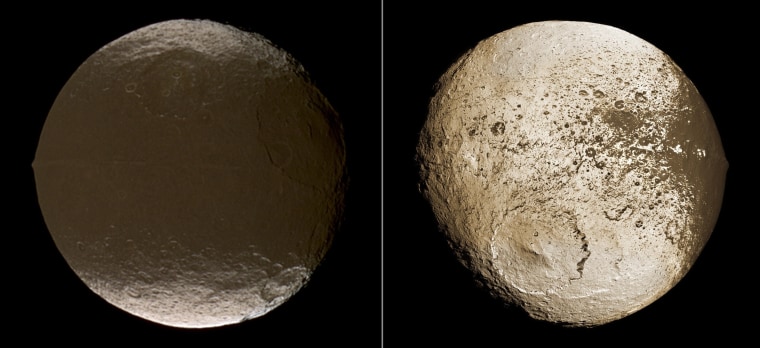New data from NASA's Cassini spacecraft at Saturn helps explain the bizarre yin-yang appearance of the ringed planet's odd moon Iapetus, where one side is dark and the other is bright.
The images and heat-mapping data collected by Cassini support the leading explanation of the moon's strange appearance, which suggests that migrating ice makes half the moon reflective and bright, while the other half is dust-covered and dark.
The new findings are described in two papers published online Thursday by the journal Science. The Cassini spacecraft launched in 1997 and has been orbiting around Saturn since 2004.
Astronomers have been puzzled by the moon's two-toned exterior for more than 300 years. When the French-Italian astronomer Giovanni Domenico Cassini discovered Iapetus in 1671, he noticed that the surface is much darker on its leading side, the side that faces forward in its orbit around Saturn.
Images from Voyager and the Cassini probe have shown that the dark material on the leading side extends onto the trailing side near the equator. The bright material on the trailing side, which consists mostly of water ice and is 10 times brighter than the dark material, extends across the north and south poles onto the leading side.
Cassini's Imaging Science Subsystem (ISS) cameras took pictures of Iapetus during the spacecraft's close flyby of the moon on Sept. 10, 2007.
"[Cassini's] ISS images show that both the bright and dark materials on Iapetus' leading side are redder than similar material on the trailing side," said Tilmann Denk of the Freie Universitat in Berlin, lead author of one of the Science papers.
Denk suggested that the moon's leading side is colored (and slightly darkened) by reddish dust that Iapetus has swept up, perhaps from one or more of Saturn's outer moons, in its orbit around Saturn.
The dust may be related to the giant ring around Saturn recently discovered by NASA's Spitzer Space Telescope. However, the images show that this infalling dust cannot be the sole cause of the extreme brightness disparity.
Slideshow 12 photos
Month in Space: January 2014
"It is impossible that the very complicated and sharp boundary between the dark and the bright regions is formed by simple infall of material," Denk said. "Thus, we had to find another mechanism."
Close-up images provide a clue, showing evidence for thermal segregation, in which water ice has migrated locally from sunward-facing and therefore warmer areas, to nearby pole-facing and therefore colder areas, darkening and warming the former and brightening and cooling the latter.
The second Science paper, by John Spencer of Southwest Research Institute in Boulder, Colo., and Denk, suggests that the migration of water ice plays a role. The researchers created a computer model of the moon by combining the ISS imagery with thermal observations from Cassini's Composite Infrared Spectrometer (CIRS).
CIRS observations in 2005 and 2007 found that the dark regions reach temperatures high enough (129 Kelvin, or -227 degrees Fahrenheit) to evaporate much of the ice over billions of years. Iapetus' very long rotation period, one day is equal 79 Earth days, contributes to these warm temperatures by giving the sun more time to warm the surface each day than on faster-rotating moons.
Spencer and Denk propose that the infalling dust darkens the leading side of Iapetus, which therefore absorbs more
sunlight and heats up enough to trigger evaporation of the ice near the equator.
That evaporating ice recondenses on the colder, brighter poles and on the moon's trailing hemisphere. The loss of ice leaves dark material behind, causing further darkening, warming, and ice evaporation on the leading side and near the equator. Simultaneously, the trailing side and poles continue to brighten and cool due to ice condensation, until Iapetus ends up with the extreme contrasts in surface brightness seen today.
The relatively small size of Iapetus, which is just 900 miles (1,500 kilometers) across, and its correspondingly low gravity, allow the ice to move easily from one hemisphere to another.
"Iapetus is the victim of a runaway feedback loop, operating on a global scale," Spencer said.

